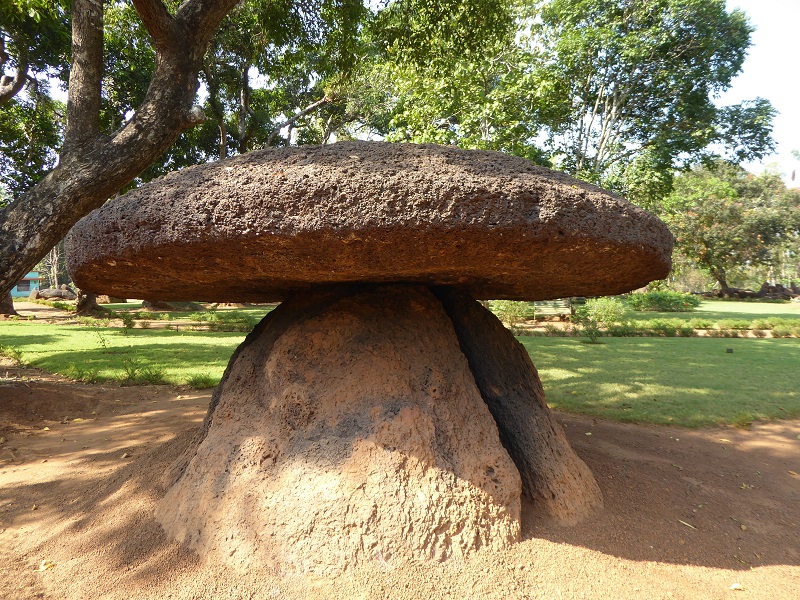<< County Introductions >> Five unusual types of Megalithic Monument to be found in Kerala, India
Submitted by Andy B on Monday, 07 August 2017 Page Views: 6987
DiscoveriesCountry: India
Megalithic monuments in Kerala mark burial sites, and types of site include Muniyara, Muthumakkathazi, Nadukkallu, Pandavakuzhi, Kudakkallu (hood stones), Thoppikkallu (hat stones), Kalmesha, and Kalvrithangal.
Muniyara Monument (dolmenoids)
Muniyara is a coastal region of Kerala best known among anthropologists and archaeologists for the remnants of ancient burial chambers. Also the region has multiple caves that, according to historians, date from 2 or 3 BC. These caves served initially as housing for Jain and Buddhist monks and later, in 68-69 AD they were used by Judaist missionary groups. Roman coins and clay pots dated to these periods have been found.
Muthumakkathazi (nannangadi)
Another megalithic monument in Kerala, Muthumakkathazi is a burial site used to bury the dead in large urns. Some ancient documents date the burial urns back to the King of the Chola's dynasty. The burial urns have different names in different regions of Kerala. For example, in the North, they are called Nannangadi but they are the same thing. The only difference is that, in some places, the bodies were buried with weapons, while in others this practice was not common. Some historians claim that the pots were used only to bury village chiefs and other prominent figures from the village.
Nadukkallu
Nadukkalu is a monument type which describes rocks used to cover burial sites. Some of these rocks were inscribed with the names of the warriors that were buried underneath them. These burial sites are linked to some Hindu rituals and other ancient traditions like “offering” alcohol, bathing and offering bali to the Nadukkallu site.
Pandavakkuzhi
Another type of burial chamber, from the Stone Age is Pandavakkuzhi, also known as Panchapandavar Padukai or Pandukkuzhi. The structure of these burial chambers was usually built with three linear stone slabs with another slab on top. Most of the structures are 3 meters in length and 1.5 meter in width. Underneath Pandavakkuzhi sites, archeologists have found burial urns with bones and weapons. During an excavation in 1946, clay utensils, pieces of plats and iron tools were discovered at Cheramanparambu, a site located close to the Thiruvanchikkulam temple. A couple of decades later, at the same burial site were discovered the ruins of white rock walls, copper coins and lamps that date from the dynasties of Rajendra Cholan and Rajaraja Cholan.
Kudakkallu (umbrella stones)
The umbrella stones are another type of megalithic monument from Kerala that were used as burial sites centuries ago. Kudakkalus are curvilinear shaped blocks installed on the ground with a block shaped like an umbrella on top. This type of burial site was discovered in various regions of Kerala including Kandanassery, Chowannur, Porkulam, Kattakampal, Eyyal and Ariyannur.
Besides Kudakkallus, another type of site in this region is Thoppikallu, which is another type of burial site, similar to Kudakkallus. The only difference between these types of burial sites is that in the case of thoppikallu the umbrella-shaped ground is not placed on top but on the ground.
I hope this has been a useful introduction to the many varied types of megalithic site to be found in Kerala. There is much more to discover in this fascinating area and to research these sites more could be an amazing travel destination for archaeologists and anthropologists.
The author Boris Dzhingarov loves to travel. He writes for several websites and is the Founder of Travel Tipsor.
<< Alex's Intrepid adventure in Syria
Japanese Chronology with Featured Stone Monuments In Every Era >>






 We would like to know more about this location. Please feel free to add a brief description and any relevant information in your own language.
We would like to know more about this location. Please feel free to add a brief description and any relevant information in your own language. Wir möchten mehr über diese Stätte erfahren. Bitte zögern Sie nicht, eine kurze Beschreibung und relevante Informationen in Deutsch hinzuzufügen.
Wir möchten mehr über diese Stätte erfahren. Bitte zögern Sie nicht, eine kurze Beschreibung und relevante Informationen in Deutsch hinzuzufügen. Nous aimerions en savoir encore un peu sur les lieux. S'il vous plaît n'hesitez pas à ajouter une courte description et tous les renseignements pertinents dans votre propre langue.
Nous aimerions en savoir encore un peu sur les lieux. S'il vous plaît n'hesitez pas à ajouter une courte description et tous les renseignements pertinents dans votre propre langue. Quisieramos informarnos un poco más de las lugares. No dude en añadir una breve descripción y otros datos relevantes en su propio idioma.
Quisieramos informarnos un poco más de las lugares. No dude en añadir una breve descripción y otros datos relevantes en su propio idioma.